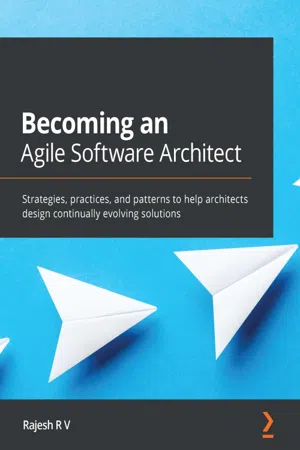
- 372 pages
- English
- ePUB (mobile friendly)
- Available on iOS & Android
Becoming an Agile Software Architect
About this book
A guide to successfully operating in a lean-agile organization for solutions architects and enterprise architectsKey Features• Develop the right combination of processes and technical excellence to address architectural challenges• Explore a range of architectural techniques to modernize legacy systems• Discover how to design and continuously improve well-architected sustainable softwareBook DescriptionMany organizations have embraced Agile methodologies to transform their ability to rapidly respond to constantly changing customer demands. However, in this melee, many enterprises often neglect to invest in architects by presuming architecture is not an intrinsic element of Agile software development. Since the role of an architect is not pre-defined in Agile, many organizations struggle to position architects, often resulting in friction with other roles or a failure to provide a clear learning path for architects to be productive. This book guides architects and organizations through new Agile ways of incrementally developing the architecture for delivering an uninterrupted, continuous flow of values that meets customer needs. You'll explore various aspects of Agile architecture and how it differs from traditional architecture. The book later covers Agile architects' responsibilities and how architects can add significant value by positioning themselves appropriately in the Agile flow of work. Through examples, you'll also learn concepts such as architectural decision backlog, the last responsible moment, value delivery, architecting for change, DevOps, and evolutionary collaboration. By the end of this Agile book, you'll be able to operate as an architect in Agile development initiatives and successfully architect reliable software systems.What you will learn• Acquire clarity on the duties of architects in Agile development• Understand architectural styles such as domain-driven design and microservices• Identify the pitfalls of traditional architecture and learn how to develop solutions• Understand the principles of value and data-driven architecture• Discover DevOps and continuous delivery from an architect's perspective• Adopt Lean-Agile documentation and governance• Develop a set of personal and interpersonal qualities• Find out how to lead the transformation to achieve organization-wide agilityWho this book is forThis agile study guide is for architects currently working on agile development projects or aspiring to work on agile software delivery, irrespective of the methodology they are using. You will also find this book useful if you're a senior developer or a budding architect looking to understand an agile architect's role by embracing agile architecture strategies and a lean-agile mindset. To understand the concepts covered in this book easily, you need to have prior knowledge of basic agile development practices.
Frequently asked questions
- Essential is ideal for learners and professionals who enjoy exploring a wide range of subjects. Access the Essential Library with 800,000+ trusted titles and best-sellers across business, personal growth, and the humanities. Includes unlimited reading time and Standard Read Aloud voice.
- Complete: Perfect for advanced learners and researchers needing full, unrestricted access. Unlock 1.4M+ books across hundreds of subjects, including academic and specialized titles. The Complete Plan also includes advanced features like Premium Read Aloud and Research Assistant.
Please note we cannot support devices running on iOS 13 and Android 7 or earlier. Learn more about using the app.
Information
Section 1: Understanding Architecture in the Agile World
- Chapter 1, Looking through the Agile Architect's Lens
- Chapter 2, Agile Architecture – The Foundation of Agile Delivery
Chapter 1: Looking through the Agile Architect's Lens

Chapter 2: Agile Architecture – The Foundation of Agile Delivery
- The journey leading to Agile software development
- Agile development and traditional architecture – an oxymoron?
- Agile and architecture – the battle between speed and sustainability
- Comparing different scaling Agile frameworks
- Measuring Agile architecture
- Lessons learned from Snow in the Desert

Technical requirements
The journey leading to Agile software development
Table of contents
- Becoming an Agile Software Architect
- Contributors
- Preface
- Section 1: Understanding Architecture in the Agile World
- Chapter 1: Looking through the Agile Architect's Lens
- Chapter 2: Agile Architecture – The Foundation of Agile Delivery
- Section 2: Transformation of Architect Roles in Agile
- Chapter 3: Agile Architect – The Linchpin of Success
- Chapter 4: Agile Enterprise Architect – Connecting Strategy to Code
- Chapter 5: Agile Solution Architect – Designing Continuously Evolving Systems
- Section 3: Essential Knowledge to Become a Successful Agile Architect
- Chapter 6: Delivering Value with New Ways of Working
- Chapter 7: Technical Agility with Patterns and Techniques
- Chapter 8: DevOps and Continuous Delivery to Accelerate Flow
- Chapter 9: Architecting for Quality with Quality Attributes
- Chapter 10: Lean Documentation through Collaboration
- Chapter 11: Architect as an Enabler in Lean-Agile Governance
- Section 4: Personality Traits and Organizational Influence
- Chapter 12: Architecting Organizational Agility
- Chapter 13: Culture and Leadership Traits
- Other Books You May Enjoy